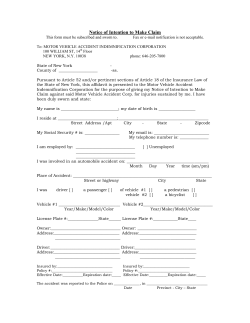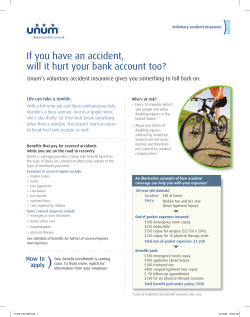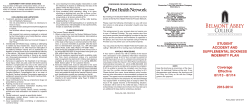
Fire Extinguishers A Health and Safety Guideline for Your Workplace Introduction
A Health and Safety Guideline for Your Workplace Fire Extinguishers Introduction Fire Extinguishing Methods Fire extinguishers are designed to put out or control small fires. A small fire, if not checked immediately, will soon spread out of control. In fact, most big fires start out as small ones. It is important, therefore, that you equip your workplace with the proper fire extinguishers as part of your fire protection plan. It’s also the law. Fires can be extinguished in one or four ways: 1. By cooling: Water is used to cool the burning material below the temperature at which it starts to burn. 2. By smothering: Carbon dioxide (CO2) or foaming agents are used to smother the burning material so that air is excluded. 3. By removing the fuel: This is usually very difficult to do. An example is turning off a fuel line. 4. By disrupting the chemical chain reaction or interrupting the flame: Dry chemicals or halon are used to do this. For a fire extinguisher to be effective, the following conditions must be met: the extinguisher must be right for the type of fire; it must be located where it can be easily reached; it must be in good working order; the fire must be discovered while it is still Types of Extinguishers small; the person using the extinguisher must be To help in choosing the proper extinguisher, fires are classed A, B, C, or D, according to the type of fuel (e.g., paper, grease, oil) that is involved in the fire. Extinguishers are available for use on one or more classes of fire, depending on the extinguishing agent they contain (e.g., water, chemicals). Figure 1, on the next page, will help you to match types of extinguishers to different classes of fire. trained to use it properly. This guideline discusses fire extinguishing methods, types of extinguishers and their proper selection, location, identification, maintenance and use. It also covers employee training and outlines the legal requirements for extinguishers in workplaces. Fire Extinguishers © Industrial Accident Prevention Association, 2006. All rights reserved. 1 Figure 2: Specific Types of Fire Extinguishers and their Uses Some extinguishers are suitable for one class of fire only; others can fight two or even three classes of fire. However, no extinguisher will fight all four classes of fire. Figure 2 gives examples of specific types of fire extinguishers, how they work, and the class(es) of fire on which they can be used. Water ` ` ` Figure 1: Matching Classes of Fire and Types of Extinguishers Fuel Sources Class of Fire A Flammable liquids (e.g., oils, grease, tar, gasoline, paints, thinners) B Electricity (e.g., live electrical equipment) C CO2; halon; dry chemical Combustible metals (e.g., magnesium, titanium) D Dry powder (suitable for the specific combustible metal involved) 1. 2. Multi Purpose Dry Chemical Type of Extinguisher (Extinguishing Agent) Ordinary combustibles (e.g., trash, wood, paper, cloth) ` ` ` Water; chemical foam; dry chemical1 Chemical Foam ` ` Carbon dioxide (CO2); halon2; dry chemical; aqueous film forming foam (AFFF) ` Compressed Gas ` ` ` Pressurized, pump type Cools fire Use on Class A fires Do not use on B or C fires Stored pressure type Smothers fire with layer of powder Use on Class A, B and C fires Aqueous film forming foam (AFFF) type Smothers fire with foam Use on Class A and B fires Halon, CO2 types Smothers fire with gas Use on Class B and C fires Selection Dry chemicals, CO2 and halon can be used on Class A fires, but may not be effective on their own. They need to be supplemented with water. Using the wrong extinguisher to fight a fire can have serious results. For example, if a water-based extinguisher is used on a flammable liquid fire (Class B fire), the fire may flare up, spread, and cause personal injury to the user and others. If a water-based extinguisher is used to fight a fire in or near electrical equipment (Class C fire), the user could suffer an electric shock. Halon extinguishers are no longer made, but some may still be in use. Dangerous gases are formed when halon is used to put out fires. Wear proper respiratory equipment, particularly in enclosed spaces. After use, do not allow anyone to enter the area until it has been well ventilated. Fire Extinguishers © Industrial Accident Prevention Association, 2006. All rights reserved. ` 2 Follow these steps in selecting extinguishers for your workplace: 3. Consider other factors that affect selection: 1. Conduct an assessment to identify your fire hazards and determine the type of extinguishers needed. The extinguishers you select must match the classes of fire most likely to occur. Remember to check your material safety data sheets to identify materials that could catch fire. The section on fire fighting measures give information on the type of extinguishing agent needed to put out a fire involving the material. 2. Determine the size of potential fires in each area and how fast they could spread. Extinguishers for Class A and Class B fires are rated for the size of fire they can handle. This rating appears on the label and is expressed as a number from 1 to 40 for Class A fires and 1 to 640 for Class B fires. The higher the number, the larger the fire the extinguisher can put out. However, the higher the rating, the heavier the extinguisher. Extinguishers rated 2A:10B:C are suitable for home or office fires. Possible health and safety hazards from chemical reactions between the extinguishing agent and the burning materials, or when using certain types of extinguishers in unventilated areas. Extinguishers with long-range nozzles, for example, are available for use in confined spaces or other hazardous areas. ` Atmospheric conditions in areas where extinguishers are located. Extreme cold, for example, could make water-based extinguishers ineffective. Where there may be corrosive fumes, select fire extinguishers that can resist corrosion, or provide protection against corrosion. ` Physical abilities of the user. The size and weight of extinguishers should match the physical abilities of those who have to use them. Extinguishers shouldn’t be too heavy for employees to handle. 4. Make sure that your extinguishers: Extinguishers for Class C fires depend upon such factors as the size of the electrical equipment, how it is constructed, whether it is enclosed, and the nature of the other combustible materials in the area. ` are approved by a recognized laboratory (replaced or new extinguishers must be approved by the Underwriter’s Laboratories of Canada or ULC, and labelled as such); ` do not contain carbon tetrachloride, methyl bromide, or other toxic vaporizing liquids. 5. Do a reassessment whenever you make changes in your workplace, e.g., when you change a work process or the materials you are using. Agents for Class D fires should be carefully selected based on information in the material safety data sheet and the manufacturer’s recommendations. The amount of agent needed depends on the surface area of the metal, and its shape and form. Location No matter how carefully they are selected, fire extinguishers won’t be of any use if they can’t be reached in an emergency. Locate extinguishers where they can be readily reached for use while a fire is still small. However, don’t locate them where they could be a hazard to employees, or where they could get damaged. Consult the Ontario Fire Code or your local fire department to determine the number of fire extinguishers you need for your workplace. Fire Extinguishers © Industrial Accident Prevention Association, 2006. All rights reserved. ` 3 If not equipped with wheels, ensure that portable extinguishers weighing more than 18 kilograms (kg) or 39 pounds (lbs.) are installed so that the top is not more than 1.1 meters (m) or 3.6 feet (ft.) above the floor. Those weighing 18 kg or less must not be more than 1.5m (5 ft.) above the floor. Post signs to show the locations of fire extinguishers, particularly in large floor areas where they could be easily blocked from view. The signs should be large enough to be seen clearly from a distance. Figure 3 gives an example of a fire extinguisher sign. Here are some general pointers for where to locate extinguishers in your workplace. Locate them: Figure 3: A Fire Extinguisher Sign ` so that they are visible, along with their operating instructions and identification marks; ` where they can be easily reached (i.e., they must not be blocked by machines or materials); ` in or near corridors or aisles leading to exits – however, they must not block aisles; ` close to potential fire hazards, but not so close that they could be damaged or cut off by a fire; ` where they will not expose people using them to undue risk, e.g., using a halon extinguisher in an unventilated area; ` where they will not be damaged by moving trucks, cranes or other work activities, or corroded by chemical processes; ` so that they are protected against the elements (if stored outdoors). Identify walls or columns on which extinguishers are mounted with a red band. The band should be about 2.4 to 3m (8 to 10 ft.) above the extinguisher. The background on which the extinguisher is mounted should also be painted red. See Figure 4. In special areas Figure 4: Wall-Mounted Extinguisher Where highly combustible material is stored in small rooms or enclosed spaces: ` locate the extinguisher outside of the room (this will force the potential user to exit the room and then decide whether to re-enter it to fight the fire). For service rooms that contain electrical equipment: ` locate extinguishers in or near the room. On vehicles or in areas where extinguishers are subject to jarring or vibration: ` mount extinguishers on brackets designed to withstand vibration. Fire Extinguishers © Industrial Accident Prevention Association, 2006. All rights reserved. 4 Figure 6: Picture Markings Showing Suitability according to Class of Fire Identification Manufacturers place markings on extinguishers to indicate the class or classes of fire for which they are suitable. To make identification easier in an emergency, consider applying class ratings to wall panels near extinguishers. There markings should be easy to see from a distance of 4.6m (15 ft.). Note regarding colours (if used): One marking system uses letters, symbols and colours (see Figure 5). ` Background for “YES” symbols is blue. ` Background for “NO” symbols with slash mark (“NO”) is black. For Class A fires A Trash, Wood, Paper B Liquids, Grease Another marking system uses pictures which show both the uses and non-uses of the extinguisher. This marking system is illustrated in Figure 6. Pictures give more information, but employees will need training to be able to recognize and understand them. C Electrical For Class A, B fires Note that with both marking systems, the use of colour is optional. A Trash, Wood, Paper B Liquids, Grease C Electrical Figure 5: Symbol and Colour Marking on Extinguishers Symbol Description Ordinary Combustibles Extinguishers for Class A fires are identified by a triangle containing the letter “A”. If coloured, the triangle is green. A Flammable Liquids B Electrical Equipment C Combustible Metals D For Class B, C fires A Trash, Wood, Paper B Liquids, Grease C Electrical Extinguishers for Class B fires are identified by a square containing the letter “B”. If coloured, the square is red. For Class A, B, C fires Extinguishers for Class C fires are identified by a circle containing the letter “C”. If coloured, the circle is blue. A Trash, Wood, Paper B Liquids, Grease Extinguishers for Class D fires are identified by a star containing the letter “D”. If coloured, the star is yellow Fire Extinguishers © Industrial Accident Prevention Association, 2006. All rights reserved. 5 C Electrical Maintenance Recharging Extinguishers must be properly maintained to ensure that they will work when needed, and that they are safe to use. A carbon dioxide extinguisher, for example, can build up a high static charge if it is used when there is a breakdown of the insulation around the discharge horn. This can cause electric shock Recharge spent extinguishers immediately and return them to their locations. Follow manufacturer’s instructions for recharging. Servicing Completely examine each extinguisher at least once a year, and whenever your monthly inspections indicate that this may be needed. Adequate maintenance of extinguishers consists of regular inspections, recharging as needed, and a complete annual checkup and servicing. Records must be kept of all maintenance work carried out, including inspections. Replace defective parts and extinguishers, recharge extinguisher as needed, and ensure that hydrostatic tests are carried out according to the manufacturer’s instructions. Testing and servicing is usually carried out by a service agency. If employees in your company look after testing and servicing, they must be trained and fully qualified to do so. Extinguishers that contain Halon 1211 or 1301 must be serviced according to the requirements of O. Reg. 413/94 under Halon Fire Extinguishing Equipment, of the Environmental Protection Act. Inspections Set up a maintenance schedule for extinguishers so that they are not all out of service at the same time. Fire extinguishers must be inspected at least once a month, and more often where needed. Inspections are visual checks to determine that: ` ` ` The extinguisher is well supported: Record Keeping − hangers are fastened solidly. Attach a durable tag to each extinguisher that shows: It is accessible: − can be easily reached; − location signs are clear; − class markings are clear; − operating instructions are clear. It is in working condition: ` dates of monthly inspections, recharging, and servicing; ` name of servicing agency; ` signature of person who performed the service. − discharge opening is clear; Maintain a permanent record for each fire extinguisher that shows: − is fully charged; ` serial number and type of extinguisher; − has not been tampered with; ` location of extinguisher; − is not damaged; ` inspection date; − hydrostatic testing has been done. ` description of maintenance work or hydrostatic tests carried out; ` date of next inspection; ` date of scheduled annual servicing; ` inspector’s comments; ` inspector’s signature. ` The ring pin is in place. ` The seal is intact. Fire Extinguishers © Industrial Accident Prevention Association, 2006. All rights reserved. 6 Extinguisher Use ` when and how to use extinguishers; As soon as a fire is discovered: ` importance of sounding the alarm; ` Sound the alarm and start to evacuate. ` health and safety hazards; ` Call the fire department. ` personal protective equipment. These are important steps for everyone’s safety, even if you feel the fire can be brought under control by using an extinguisher. Use lectures and demonstrations, and give employees plenty of opportunity to practice using extinguishers. Consider having them practice on extinguishers that need recharging. With increased confidence, employees are more likely to respond effectively to fire emergencies. Tips for safe extinguisher use: ` Test that the extinguisher works before you approach the fire. ` Protect yourself at all times. ` Take care. Speed is essential but it is more important to be cautious. ` Keep your back to the exit at all times and stand 2 to 2.4m (6 to 8 ft.) away from the fire. ` Make sure employees are aware of the operating instructions posted by extinguishers. Provide retraining as needed. What the Law Says Occupational Health and Safety Act Follow the 4-step P-A-S-S procedure: Section 123 of the Regulation for Industrial Establishments (R.R.O. 851/90) specifies that the requirements of the Fire Code respecting fire extinguishers apply at industrial establishments. 1. Pull the pin (release the lock latch or press the punch lever). 2. Aim the nozzle at the base of the fire. Ontario Fire Code (Ontario Regulation 388/97) 3. Squeeze or press the trigger. 4. Sweep the extinguisher from side to side. Section 6.2 contains requirements with respect to fire extinguishers: If the fire does not go out immediately or the extinguisher appears to be getting empty, leave the area at once. Back out with the lever squeezed and the nozzle pointed at your feet. This will help protect you until you are out of the area. Employee Training extinguisher locations; ` classes of fire most likely to break out in your workplace and the proper extinguishers to use; ` markings on extinguishers; Fire Extinguishers © Industrial Accident Prevention Association, 2006. All rights reserved. 6.2.1 – General; ` 6.2.2 – Classification; ` 6.2.3 – Selection requirements; ` 6.2.4 – Installation requirements; Clause 6.2.4.1.(1) specifies that portable extinguishers shall be installed in every building; All employees who may be required to use fire extinguishers should receive training. Training should cover: ` ` 7 ` 6.2.5 – Grading of hazards; ` 6.2.6 – Distribution; ` 6.2.7 – Inspection, testing and maintenance The following subsections contain requirements for extinguishers in specific locations: ` 3.2.1.5 – Woodworking operations; ` 3.4.2.6 – Fuel-fired industrial trucks; ` 3.4.3.4 – Charging installations for batterypowered industrial trucks; ` 5.14.5.6 – Spray painting operations; ` 5.17.33 – Welding or cutting operations. © INDUSTRIAL ACCIDENT PREVENTION ASSOCIATION, 2006. All rights reserved. As part of IAPA’s mission to inform and educate, IAPA permits users to reproduce this material for their own internal training and educational purposes only. For any other purpose, including use in conjunction with fee for service or other commercial activities, no part of this material may be used, reproduced, stored in a retrieval system, or transmitted in any form or by any means, electronic, mechanical, photocopy, recorded, or otherwise, without the express prior written permission of the Industrial Accident Prevention Association. The information contained in this material is provided voluntarily as a public service. No warranty, guarantee or representation is made by IAPA as to the correctness, suitability, fitness, or sufficiency of any information contained in this material. Use of this material means that the user agrees that IAPA and its employees will not have and are released from any liability whatsoever, however caused or arising, in connection therewith. Users also acknowledge that it cannot be assumed that all acceptable safety measures are contained in this material or that additional measures may not be required in the conditions or circumstances that are applicable to the user or his/her organization, and that the user will personally make his/her own assessment of the information contained in this material. Environmental Protection Act O. Reg. 413/94 respecting Halon Fire Extinguishing Equipment. Resources For more information, consult the following: ` National Fire Protection Association (NFPA). Fire Protection Handbook, 2003 Edition ` NFPA, National Fire Code 10 – standard for “Portable Fire Extinguishers.”, 2002 (Next Revision Cycle starts in 2005) ` Suppliers’ material safety data sheets for the hazardous materials used in you workplace While IAPA does not undertake to provide a revision service or guarantee accuracy, we shall be pleased to respond to your individual requests for information. Revised: March 2006 Industrial Accident Prevention Association Toll-free: 1-800-406-IAPA (4272) Website: www.iapa.ca Fire Extinguishers 8
© Copyright 2025














